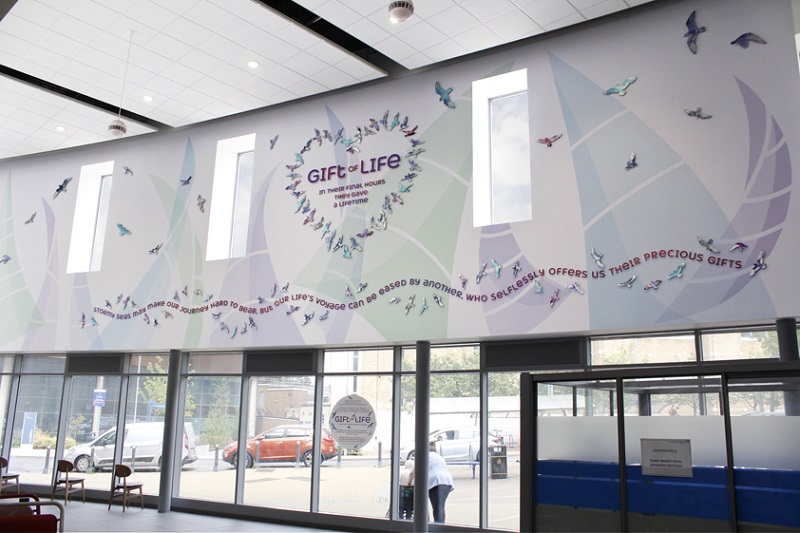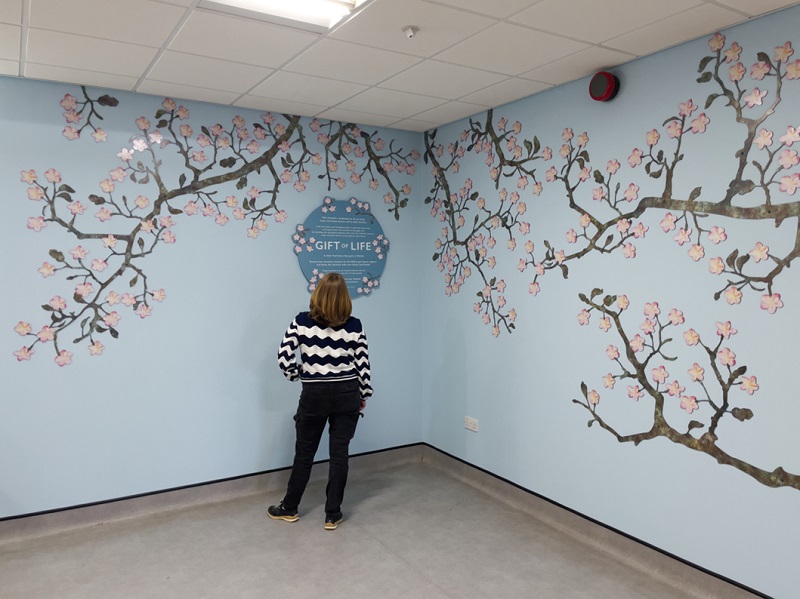Organ donation and transplantation is one of the greatest success stories of modern medicine, saving and transforming thousands of lives.
Since last year all adults in England, Wales, and Scotland are now considered to have agreed to be an organ donor when they die unless they have decided to ‘opt out’.
But still, every single year, hundreds of opportunities for transplants are missed.
Tony van de Bospoort of Hospital Art Studio, which has undertaken a number of art-based commissions to encourage and acknowledge organ donation, said: “It doesn’t matter if organ and tissue donation in a hospital is a common occurrence, or only two or three donors a year, it’s essential that everyone understands the importance of donation so there are no missed opportunities.
“This is why a recognisable donation memorial is so useful to get across the message to every department in your hospital, as well as to the local community.”
Dale Gardiner, national clinical lead for organ donation, adds: “Just as there is a war memorial in every park, every hospital should have a donation memorial. It’s a small way to say to donors ‘you are not forgotten and thank you!’.”

Sails and Seabird at Southampton Hospital includes a descriptive plaque and poems, helping to get the message across
Choosing a memorial
When a memorial is referred to, what may immediately come to mind is something sombre as found in a graveyard or a war memorial.
But a donation artwork can be attractive yet prominent, featuring elements from nature in order to symbolise regeneration and thereby creating an uplifting and inspiring artwork that also acts as a memorial for donor families.
van de Bospoort explains: “These artworks will always be a permanent feature for a hospital, created as an outdoor sculpture, a suspended ceiling sculpture, or a wall artwork, and can be as big as the four-storey-high wall artwork in Birds of Medway, or as small as your budget and space allow, such as Apple Blossom in Milton Keynes.”
Commenting on the impressive installation at Medway Maritime Hospital, created by Hospital Art Studio, the hospital’s clinical lead for organ donation, Dr Paul Hayden, said: “The artwork stimulated discussion about organ donation and hopefully this will continue to increase the number of visitors who agree to donate their organs.”Promoting organ and tissue donation
Hospitals can often be scary or intimidating for patients; and art is a perfect way to create a calmer and more-welcoming environment.
van de bospoort said: “A striking donor artwork has even more significance and actually encourages people to engage.
“A descriptive plaque, or some poetic wording, such as in the Sails and Seabirds wall artwork in Southampton or in Atrium of Butterfly’s suspended glass artwork in Wrexham, can help contextualise and impart meaning.
“Once visitors are engaged, artworks can keep organ and tissue donation at the forefront of people’s minds.”

The Apple Blossom installation at Milton Keynes Hospital is an example of an organ donation artwork on a small scale
Engaging communities
Taking onboard local landmarks and the general landscape is important in the beginning of the design process, thereby building strong relationships with local communities, service users, and staff.
van de Bospoort said: “As a donor artwork develops it’s important to ensure that the finished piece displays a strong sense of identity that is helpful in encouraging positive engagement.
“The hospital’s geographical location could instigate ideas and imagery that instil pride and fond memories for the local community.
“An Hourglass of Butterflies at Winchester and Basingstoke utilises butterflies that are indigenous to a nearby nature reserve, while birds native to Yorkshire gather among tree branches in Bradford’s A Tree of Yorkshire Birds, and sycamore seeds that are also known as ‘little helicopters’ represent a town associated with the manufacture of helicopters in Yeovil’s Verdigris Sycamore Seed sculpture.”
He added: “If you have a donor recognition artwork, use it as a beacon, a place to meet and greet in your hospital, raising awareness of the importance of donation.
“Hospitals which already have a donation artwork have made the most of it by including the artwork in all promotion, such as on banners and leaflets, social media platforms, promotional videos on YouTube, press releases, and newspaper articles.”
Securing funding
It is important to consider and agree with your Organ Donation Committee how best to use funding available.
If you have a donor recognition artwork, use it as a beacon, a place to meet and greet in your hospital, raising awareness of the importance of donation
This funding might consist of the donor recognition funding available to, but some committees may also have access to charitable or other funding.
Richard Burbedge, a double lung transplant patient at Royal Berkshire Hospital, said of the impact of artwork: “This provokes thought about organ donation but is also a sign of being reborn.
“The enormity of the piece at the Royal Berkshire really helps to get the message across.
“Organ donation has transformed my life beyond recognition and it’s the greatest gift you can give.”




